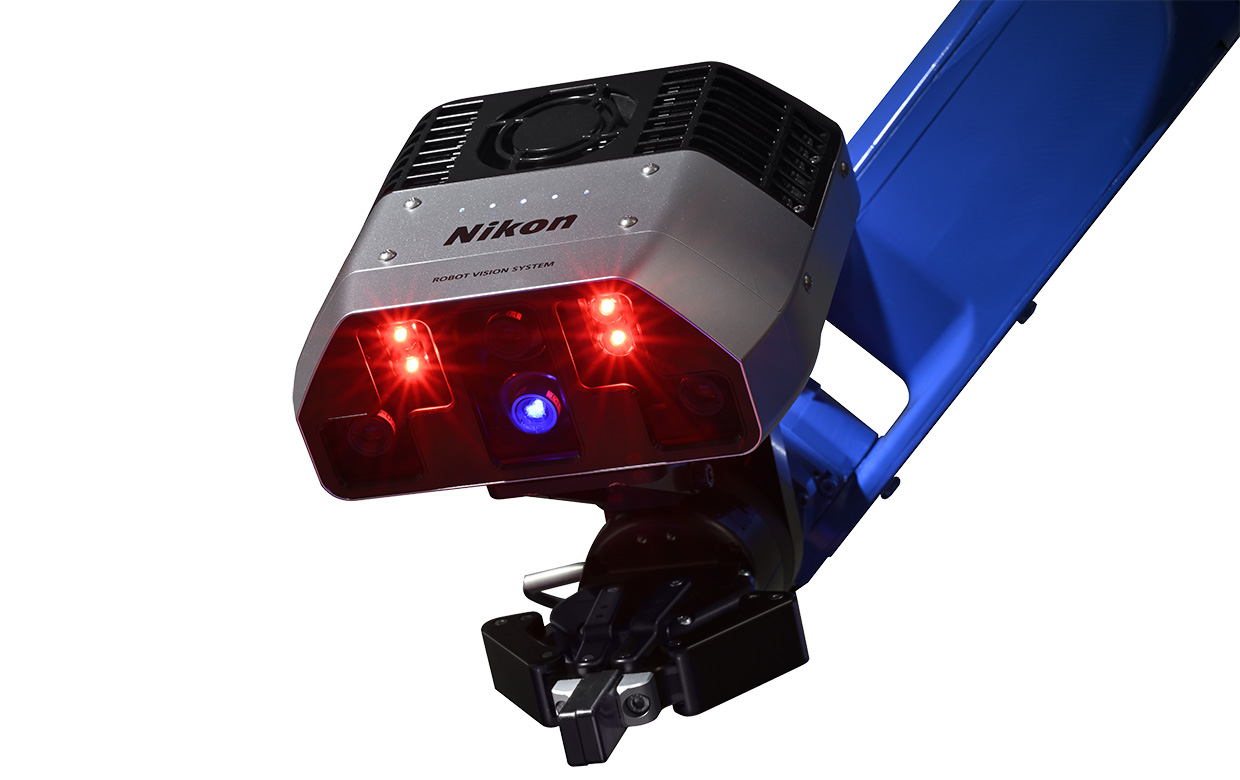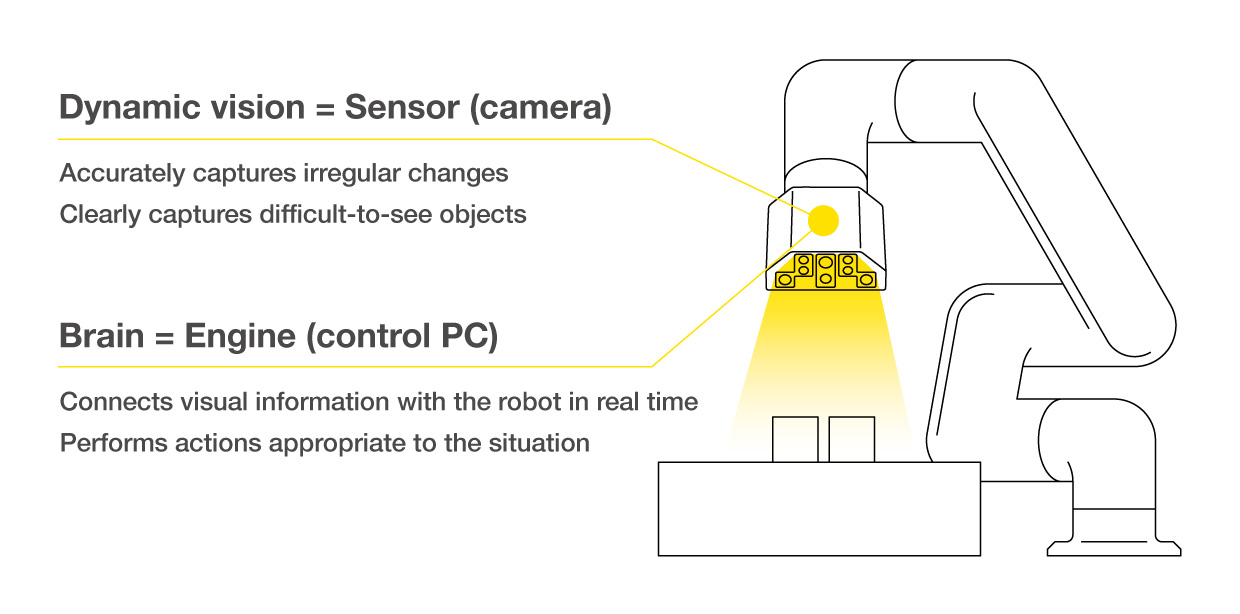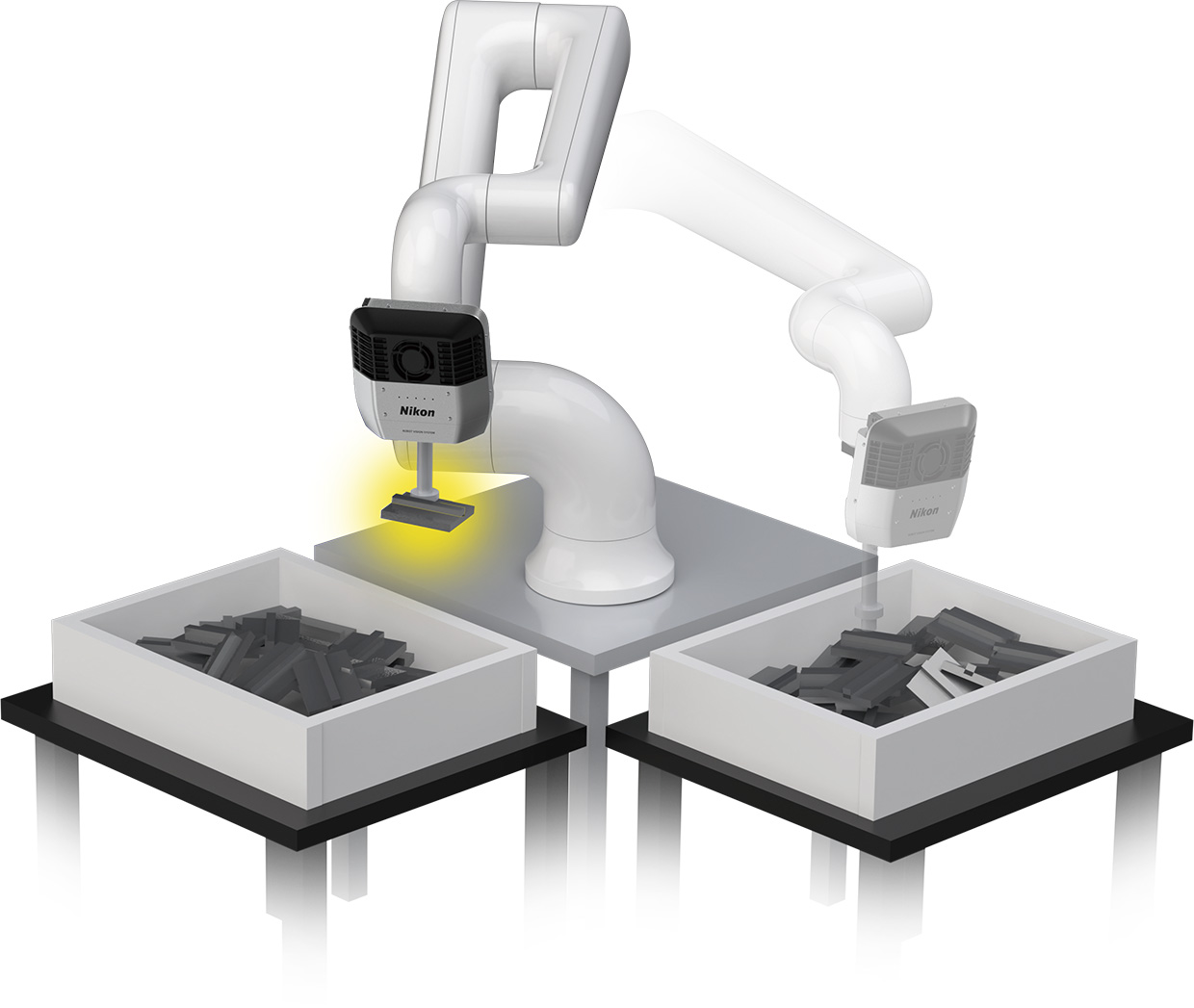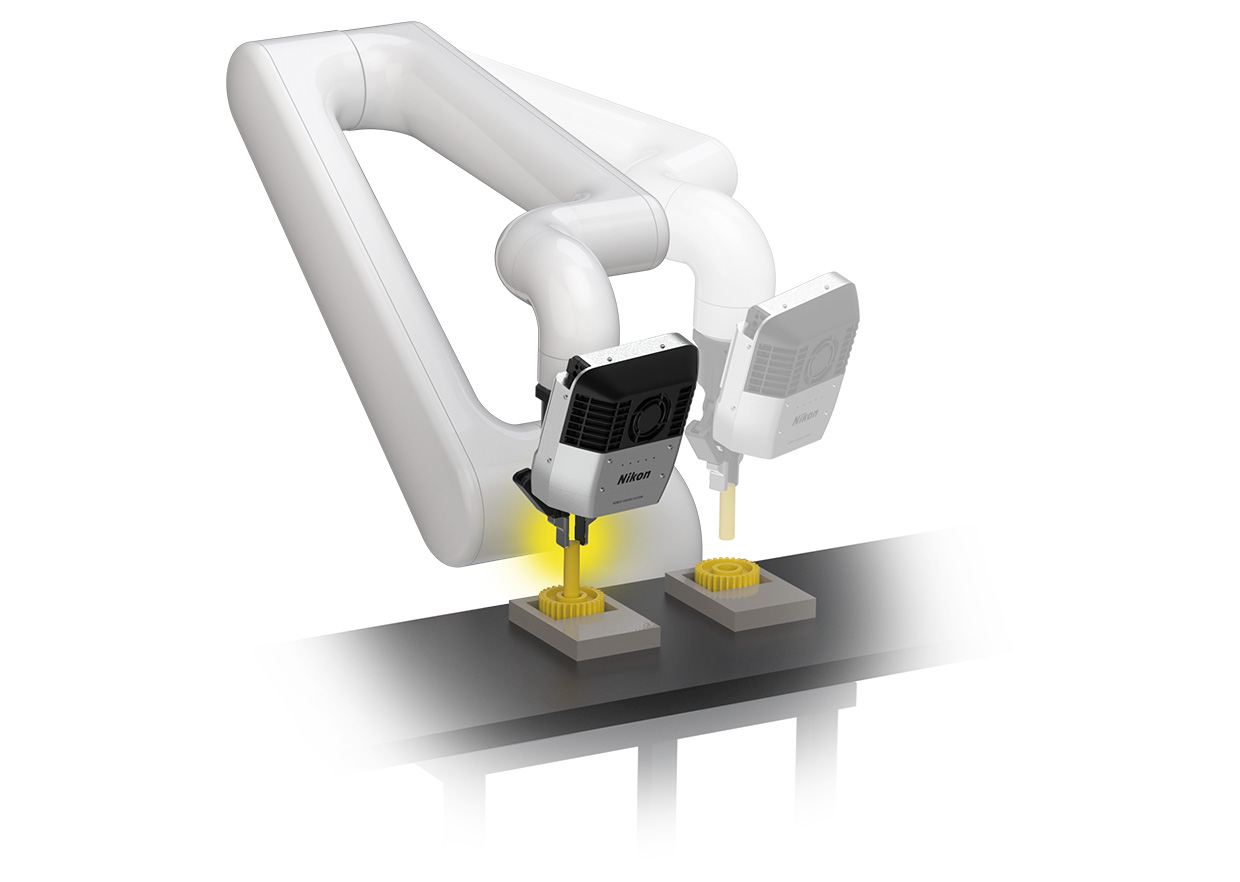Nikon releases industrial robot vision system
Realization of high-speed, flexible operations for robot arms
May 7, 2024

TOKYO - Nikon Corporation (Nikon) will release an industrial robot vision system in fall 2024. This product is a vision system that is attached to an industrial robot arm. It is configured with a sensor (camera) that senses conditions in the same way as a human eye and an engine (control PC) that recognizes imaged objects by means of image processing and makes decisions concerning them, thus adding dynamic vision and brain functions to the robot arm. Nikon's robot vision system operates at high speed, has excellent recognition capabilities, and is easy to use due to its unique high-speed sensing technology, and contributes to reducing labor and improving productivity in many industries, including manufacturing.
This product will be exhibited as a demonstration product at the Robot Technology Japan (at Aichi Sky Expo) exhibition that will be held from July 4 to 6.

Overview of release
| Model number | “NSP-150-1”, “NSP-250-1”, “NSP-500-1” |
|---|---|
| Release date | Fall 2024 |
Background of development
Demand for multiproduct variable-volume production is increasing at production sites in various industries including the automotive industry, and production, quality, and inventory management are becoming more complex. There are also social elements to consider, such as the increasingly serious labor shortage. Thus, there is a growing demand for automating simple tasks by utilizing a robot that can work quickly and accurately. Due to this growing demand, robot vision systems are being developed by many companies; however, there are various issues. For example, a lack of processing capacity may result in difficulty in recognizing certain parts, operation/recognition may not match the required speed, the system may be difficult to use because of difficult and time-consuming pre-use settings, and introducing extra equipment may place a heavy burden on the system. Thus, there was a need to develop a robot vision system that can solve these problems.
Main applications/features
1. Bin picking
A unique, high-speed algorithm combining 2D and 3D cameras enables "bin picking", which recognizes the position of and removes workpieces randomly stacked in a box. Since it enables route setting that avoids other workpieces, loosely stacked workpieces can be picked up without damaging them and, even if the target gripping position and the actual gripping position deviate, it is possible to reperform measurement after grabbing the workpiece to continue the operation while correcting the deviation.

Improving workpiece picking rate by reducing blind spots
Taking advantage of the characteristics of hand-vision type sensor, in which a camera is attached to the tip of the robot arm, workpieces with shapes that were previously difficult to recognize from directly above can also be recognized by tilting the robot arm so that, when there is no recognizable workpiece within the field of view, the camera searches for workpieces from a different angle. The system is also equipped with a retry function whereby, if a workpiece is not found at the initial measurement position, the robot moves to an arbitrary position and measures from a different image capture position. Using these functions, the system can realize a workpiece picking rate of 100%*1.
- *1With specific workpieces, in a test conducted in Nikon's environment
Reduces takt time with high-speed operation at up to 250fps
The system achieves high-speed measurement at up to 250fps in both 2D and 3D, by applying image processing technology that Nikon has cultivated through its camera development. This enables high-speed operation of robot arms that instantly assesses conditions and achieves a 2 second*2 operating time from measurement of the workpiece to movement of the robot arm.
- *2In a test conducted in Nikon's environment
Flexible relocation/expansion due to employment of hand vision
In existing fixed vision systems, equipment for affixing the camera needs to be incorporated, restricting the layout of the production site and making it necessary to reassemble the equipment whenever processing is changed.
For this product, which includes hand vision, there is no need to design complex equipment or purchase external equipment. It flexibly responds to the needs of relocation and expansion of production processes.
2. Vision tracking
Workpieces running on transport equipment such as a conveyor, AGV, or AMR can be recognized by measurement at up to 250fps and high-speed robot arm control to achieve vision tracking, which picks and assembles workpieces while smoothly tracking objects without stopping the transport equipment.
Also, because the system utilizes hand vision, the robot hands and workpieces can be sensed within a single field of view. Minor shakes and errors in gripping position that are generated in the moving workpiece and tip of the robot hand can be instantly corrected. This function can respond to sudden stoppages of transport equipment, workpieces whose orientation is likely to change, etc. during the production process.

No synchronization work and reduced setup time
With existing robot vision systems, it is necessary to prepare transport equipment that meets system specifications and programming to synchronize the movements of the transport equipment and the robot arm, making fine movement adjustment necessary. This leads to the problem of long lead times prior to start of operations. In addition, even after operation has begun, there are many cases where the robot arm cannot work properly due to slight wobbling or sudden movement of the transport equipment.
Since this system can track a workpiece as it sees it, it does not need to be synchronized with the transport equipment. The time and effort required for the setup can therefore be reduced.
Reduced capital investment cost
Existing robot vision systems have low image processing speeds, meaning movement of the robot arm cannot keep up with the speed of existing transport equipment. They are therefore sometimes supported manually, or operations are sometimes carried out offline*3, separately from the production line.
This system enables quick action with high-speed measurement at 250fps, and introduction of a robot vision system is possible utilizing existing transport equipment. There is no need for additional capital investment for offline work or securing space.
- *3A method that is carried out by setting up a work process separately from the production line. A method for moving workpieces between the production line and offline is required.
3. Software that anyone can easily use
Reduced teaching cost due to automation and simplification of various settings
Anyone can configure settings regardless of their skill level by automating some of the settings required, from adding a new workpiece to executing picking, such as grip position setting*4 and route setting*5, significantly shortening setup time, which is normally a long time. With this, adding workpieces can be realized in as little as 20 minutes*6.
- *4Gripping position, method, target accuracy, and final action can be easily set with a simulation on the PC, simply by registering 3D models of the target workpiece and the hand.
- *5A route that avoids interference with boxes and other workpieces can be automatically generated just by registering a CAD model of the surrounding environment.
- *6With specific workpieces, in a test conducted in Nikon's environment
Streamlining the management of multiple engines by utilizing data (optional, under development)
CAD data and operating parameters can be centrally managed on the server, and CAD data updates and parameter adjustments when switching workpieces can be made offline while the robot arm is operating.
It is also possible to carry out parameter adjustments and adjustment result confirmation using error information such as abnormal images and parameter data stored on the server. With this function, you can analyze the causes of errors and consider measures to prevent recurrence offline.
Main performance
Swipe horizontally to view full table.
| Model number | NSP-150-1 | NSP-250-1 | NSP-500-1 | |
|---|---|---|---|---|
| Front field of view (mm) | 150x110x150 | 260x200x400 | 430x320x330 | |
| Optimal imaging field of view (mm) | 200x150x200 | 330x250x500 | 670x500x500 | |
| Rear field of view (mm) | 250x190x250 | 400x300x600 | 910x680x670 | |
| Resolution (pix) | High-resolution mode: 1408x1056; high-speed mode: 704x528 | |||
| Measurement speed (fps) | High-resolution mode: max. 35; high-speed mode: max. 250 | |||
| Weight of sensor (kg) | 2.8 | |||
| Dimensions of sensor (mm) | 191(W)x182(D)x78(H) | |||
| Dimensions of engine (mm) | 260x240x123 | |||
| Applicable robot manufacturers |
YASKAWA, FANUC, Kawasaki Heavy Industries, Universal Robots Contact Nikon for details |
|||
| Function for each solution | Bin picking | 2D/3D recognition (partially possible), automatic collision avoidance, simple gripping position setting, retry function | ||
| Vision tracking | No conveyor connection, high-speed position correction function, predictive control function (after correction), simple edge editing | |||
- *As of May 2024. Specifications may be changed.
The information is current as of the date of publication. It is subject to change without notice.
